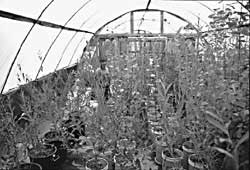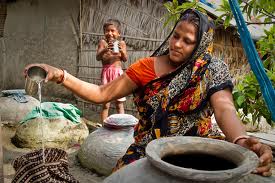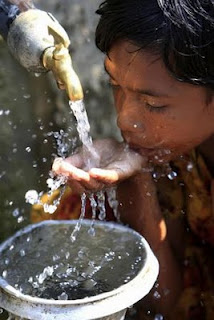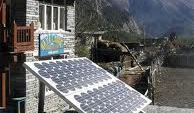The verdict
What the judiciary needs to do is to put the heat on the regulatory and executive agencies of the country and improve the country's environmental governance systems
What the judiciary needs to do is to put the heat on the regulatory and executive agencies of the country and improve the country's environmental governance systems

Technological improvement for greater efficiency faces many hurdles, especially poor immediate returns on investment

The state uses all the right words. But its actions don't match its rhetoric, unfortunately

Scientists in New Zealand have developed a low cost technology that can clean contaminated soil

Detergents are rated for how ecofriendly they are
<table width="534px" height="196" border="0" cellspacing="0" cellpadding="0"> <tr> <td width="41%"><a href="cover.asp?foldername=20070315&filename=news&sid=34&page=2&sec_id=9&p=2"><img src="../files/images/20070315/20.JPG" alt="garbage" width="293" height="196" hspace="0" vspace="0" border="0" /></a></td> <td width="1%"> </td> <td width="58%" bgcolor="000

How prepared is Bihar?
Deve Gowda s statement that environmentalists mislead people reveals an attitude which is a serious threat to the environmental movement
The heart of the matter is that the government must learn to work with the civil society, its media and the public
On global issues Kamal Nath was prepared to take positions unpalatable to his bureaucrats and worked closely with CSE. But he was not willing to go far on national issues, especially on the crucial one of participatory natural resource management
Public awareness, clear thinking and practical demands will help us monitor the government and fight for the changes that are needed
The Supreme Court has sug gested that the forested states, which lose revenue because of the ban on felling of trees should be compensated for keeping their forests intact. Protection of the
Over the past few days, Jantar Mantar has been the venue of two protests against two of worst tragedies Independent India has witnessed. On one side of the road were activists
I first learnt about slapp when we released a study about pesticides in colas. PepsiCo had filed a defamation case against us in the Delhi High Court and our lawyer, fresh out of law school in
Every chair of the community hall of the Shree Shantadurga temple in South Goa's Quepem taluka was taken. In a few minutes, the public hearing for Shakti bauxite mines was to begin. Then there arose a whisper: the temple had objected to the hearing being held in their premises; it was being called off. It was the second time the hearing was convened and this time, too, the villagers told us, the 30-day notice rule had been violated. The panchayats were informed just two days ago that people should state their objections, if any, to the expansion plan of the bauxite mine-an increase in production from 0.1 million tonnes per year to 1 million tonnes, requiring an increase in mining area from 26 ha to 826 ha-in this forest- paddy region of Goa's hinterland. From the open window I could see a large police battalion gathering. The whisper grew to a shout. Hefty transporters- owners of trucks to carry the bauxite-were shouting the expansion must be cleared. Within minutes, villagers responded. The voices became more strident; both sides were close to a fight. Things settled only when the local MLA insisted with district officials that the hearing be held as scheduled. The hearing began. The company was requested to explain its project-a Powerpoint presentation in English was simultaneously translated into Konkani. A lot of fluff and technical verbiage followed: the geology of the region; the drilling techniques to be used; how bauxite was critical to the country's development; how all clearances had been granted for extension of the mining lease; and how the company would ensure that environmental damage was mitigated at all costs. Listening to the presentation, everything seemed taken care of. The company would stabilize waste dumps by planting trees, backfilling the pits so that rejects were minimized; it would not breach the groundwater table and, to top it all, it would set aside money for environmental management. But this was before the residents- from politicians to villagers to church representatives-got up to speak. They ripped through the environmental impact assessment report prepared by an unknown consultant. They explained the company had got the number of people living in the area, and even the existing land use, completely wrong. The company claimed most of the land it would mine was 'wasteland'. This, people explained, was a lie because the company was eyeing communidade land (common land) they intensively used for agriculture or grazing livestock. Thus, mining here would massively harm them, a fact completely neglected in the environmental impact assessment. As speaker after speaker rose, it became awfully clear that even though the mine was coming up in the backyard of these people, the statutory environmental impact assessment could simply gloss over what would happen to people's land, forests, water or livelihood. I then checked the report. There was not even a map that identified for me habitations or agricultural fields. The report said, rather glibly, there were no surface waterbodies in the vicinity of the project. It then concluded the project's use of water, for spraying on roads and pits, would have no impact on availability for people. The river Sal, some distance away, was discussed for environmental impacts; even the Arabian Sea. But the numerous village streams, which flow from the hills and irrigate the fields found no mention. At the hearing, villagers counted the streams. The area used to be extremely water- scarce. But the government spent substantial money under the national watershed programme to build check dams, plant trees and increase water recharge. As a result there was now enough water for good harvests. Villagers wanted to know why the same government, which had first invested in improving their water security, was now hell-bent on pushing an activity that would destroy their lives. I wasn't surprising when all those gathered agreed unanimously that the mines must not be allowed under any circumstance. The people said the regulatory clearances-the mine closure plan, the mine management plan-were worthless or even fraudulent. The company, already mining in the area on much smaller land, had flouted every existing condition, broken every trust. Life, they said, was already a living hell because of this small mine; what would happen if it expanded? More land taken, more streams destroyed, more rejects piled high for rains to turn into silt? The questions we must ask are: how could the regulatory institutions even consider giving clearances for an expanded mine area without first checking the company's compliance record? Does this not speak of the weak and non-existent capacities of our regulators to manage the mines so that local or regional environmental damage is minimized? Does this not suggest that people who live in these areas are doomed, because once clearance is given there is nobody to check if the stipulated conditions are met? Should I be surprised I was witness to complete opposition by people to the project? What next? My colleague Chandra Bhushan tells me the rest is fairly predictable. The minutes of this public hearing will be sent to the Union Ministry of Environment and Forests. Its expert committee will deliberate, or sit, on the matter for a few months (as it is controversial). Then it will call the company to explain how it will take into account the issues raised by the people. An improved Powerpoint presentation will be made by another consultant; more deliberations will follow; new conditions will be laid down. With these conditions the expanded mine will be cleared, people's opposition be damned. I hope he is wrong. Let's track this one. The future might be different. Writer is Director, Centre for Science and Environment
The recently completed first ever research on the plant biodiversity of the Khirthar Range has found around 197 species, many with medicinal properties, which are under serious threat of extinction due to human activities, including construction, extensive chopping of trees and large shrubs for use as fuel wood, as well as ecological stress. The three-year study, funded by the Higher Education Commission (HEC), suggests immediate large-scale conservation and development of the plant biodiversity of the Khirthar Range, which, it says, has great potential for commercial exploitation for medicinal purposes that would not only reduce pressure on the wild stocks, it would also help alleviate poverty. Other recommendations include the provision of alternate sources of income and fuel to the locals and the initiation of measures to ensure minimum disturbance to the natural habitat while developing Gorakh Hill as a resort. "It's the first ever research on plant biodiversity of the entire Khirthar Range. Earlier, a baseline study was conducted in 2000, but that was only restricted to Khirthar National Park,' said Professor Dr Anjum Perveen of the University of Karachi's botany department, who conducted the research. She said that more research was needed to explore the entire plant biodiversity of the Khirthar Range that extends southwards for about 190 miles from the Mula River in east-central Balochistan to Cape Muari (Monze) west of Karachi on the Arabian Sea. "My research is a small step that needs to be strengthened by further studies. I would have loved to go to the top of the highest peak, Kutte-ji-Qabar (at about 6,878 feet above sea level) that remains covered with snow for many months, but couldn't do so without any logistical support and had to be content with the area within our reach,' she said. It was because of these limitations that eight sites were selected for research. These included Khirthar National Park, Rani Kot, Kutte-ji-Qabar, Batro Jabal, Pir Ghazi Shah and Gorakh Hill (the second highest peak of the Khirthar Range), Dureji and Tiko Baran. "A great source of limestone, gravel, salt, sand and marble, the entire Khirthar Range, that includes protected areas of Khirthar National Park, Mahal Kohistan Wildlife Sanctuary and the Sumbak Game Reserve, is covered with calcareous rocks and has a desert climate. The average temperature ranges between 44 to 48 degrees centigrade in summer and 30 to 35 degrees centigrade in winter at daytime. At night, it drops to as low as 10 to 15 degrees centigrade. The altitude varies from about 1,000 metres in the south to 2,400 metres in the north,' she responded when asked about the geographical and climatic conditions of the area. Incredible diversity The team recorded 197 plant species, distributed in 60 families, the most dominant being Poaceae, followed by Compositae, Papilionaceae and Solanaceae. Species like Neurada procumbens, Corallocarpus epigaeus, Commelina albescens, Moringa concanensis, Plantago ciliata, Plantago stocksii, Olea ferruginea, Salvadora persica, Asparagus sp., Aristolochia bracteolata, Caralluma edulis, C. tuberculata, Cometes surratense and Viola stocksii were rare species, most of which were found on Gorakh Hill. The frequently found species were Fagonia indica, Rhazya stricta, Acacia nilotica and Grewia tenax and Dodanea viscose. The two endemic species were Justicia vahlii and Ruellia sindica while Bergia suffruticosa, Seetzenia lanata and Sophora alopecuroides were the three new findings. Acacia nilotica was being extensively used as a fuel wood while Nannorophs ritchieana for making baskets and mats. Many of these plants surviving in drought conditions, she said, had medicinal properties. Some could be grown in the city and prove to be a wonderful replacement for many decorative plants that required a lot of water. For instance, Dodonaea viscosa can be used to make hedges. Among the large number of plants having medicinal properties included Plantago ciliata (ispagol), Olea ferruginea (kaho), Peganum harmala (harmal), Rhazya stricta (sewear), Tecomella undulate (rohida), Withania coagulans (paneer booti), Asparagus gharoensis (musli), Ephedra ciliata (Ephedra) and Tribulus longipetalous (gokhru). "We visited the sites from time to time during the study period and made efforts to include the representative, topographic and physiographic conditions. Though collecting specimens from inaccessible heights was an arduous task itself, the greater danger was posed by criminal elements who rule these areas and it was difficult to move independently,' she said. When asked about the most difficult and diverse spot in terms of plant biodiversity, Dr Perveen said that Gorakh Hill was the most rich. "The 5,688ft high Gorakh Hill Station is surrounded by high mountains. The most unique feature of this area is that the mercury column remains below 20 degrees centigrade even in June and July. These climatic conditions make it distinctive in vegetation, too,' she said, quickly adding that the plants had been severely damaged by construction works. "The present vegetation is already under stress due to prolonged droughts, extensive grazing, chopping and poor soil conditions. Making Gorakh Hill a resort is an excellent idea, but development shouldn't come at the cost of ecological destruction. In fact, this indigenous plant wealth can be turned into an income-generating source if the government educates locals about its significance and trains them in setting up plant nurseries,' she suggested.

<p><span style="font-size:14px;"><strong>Rain Water Harvesting</strong></span></p> <p><span style="font-size:14px;"><strong><img alt="Rain Water Harvesting-Bangladesh" src="http://www.indiaenvironmentportal.org.in/files/country/bangladesh/rainwater_harvesting_hl.jpg" style="width: 525px; height: 297px;" /></strong></span></p> <p>Rainwater harvesting is one of the feasible options of fresh water sources in the coastal areas of Bangladesh and recently a lot of initiatives and programme were undertaken to promote and install rainwater harvesting systems both in the coastal and arsenic affected areas in Bangladesh. Moreover, every year the country is also blessed with ample rain. The average annual rainfall in Bangladesh is about 2200 mm, seventy-five percent of it occurs between May and September.</p>

<p><span style="font-size:14px;"><strong>Arsenic Contamination</strong></span></p> <p><img alt="Arsenic Contamination" src="http://www.indiaenvironmentportal.org.in/files/country/bangladesh/arsenic_hl.jpg" style="width: 530px; height: 300px; border-width: 2px; border-style: solid;" /></p> <p>In the early 1970s, most people living in the countryside relied on surface water -- ponds, or rivers -- to meet their drinking water needs. As a result diseases due to bacteria-contaminated water, such as diarrhoea, dysentery and cholera were extremely widespread. To tackle this problem, and the related problem of drinking water, the government switched to a policy of tapping groundwater. The government began providing villages with tubewells and handpumps, with aid from such organisations as the United Nations Children's Fund (UNICEF) and the World Bank:UNICEF initiated the programme and paid for the first 900,000 tubewells along with its co-sponsor.</p>

<p><span style="font-size:14px;"><strong>Renewable Energy</strong></span></p> <p><img alt="" src="http://www.indiaenvironmentportal.org.in/files/country/nepal/biogas_hl.jpg" style="border-width: 2px; border-style: solid;" /></p> <p>The major energy resource base in Nepal consists of biomass, hydroelectricity, petroleum products, natural gas, and coal reserves. Among the entire energy resource base, it is evident that biomass is the dominant resource base of the country with respect to its utilization. Biomass provided 86% of the total energy consumption, petroleum 9%, which is mainly consumed by urban areas, electricity only 2% and renewable 1% of the total energy consumption.</p>

<p><span style="font-size:14px;"><strong>Food Safety in Bhutan</strong></span></p> <p><img alt="Food Safety" src="http://www.indiaenvironmentportal.org.in/files/country/bhutan/foodsafety_hl.jpg" style="width: 530px; height: 300px; border-width: 2px; border-style: solid;" /></p> <p>Bhutan regulates public health and safety in regards to food under the Food Act of 2005.<sup class="reference" id="cite_ref-FA05_13-0"></sup> The Food Act establishes the National Food Quality and Safety Commission and the Bhutan Agriculture and Food Regulatory Authority ("BAFRA"), both of which are overseen by the Ministry of Agriculture. While the Ministry of Agriculture is singularly authorized to author regulations under the Food Act, the Minister of Agriculture may delegate authority to ministries responsible for health, trade, and customs.<sup class="reference" id="cite_ref-FA05_13-1"></sup></p>